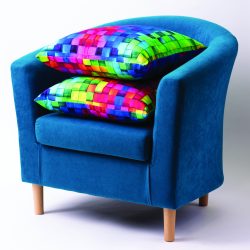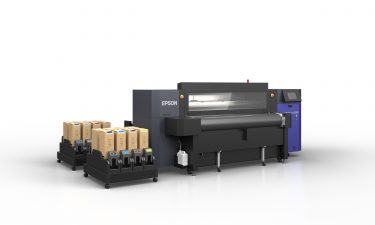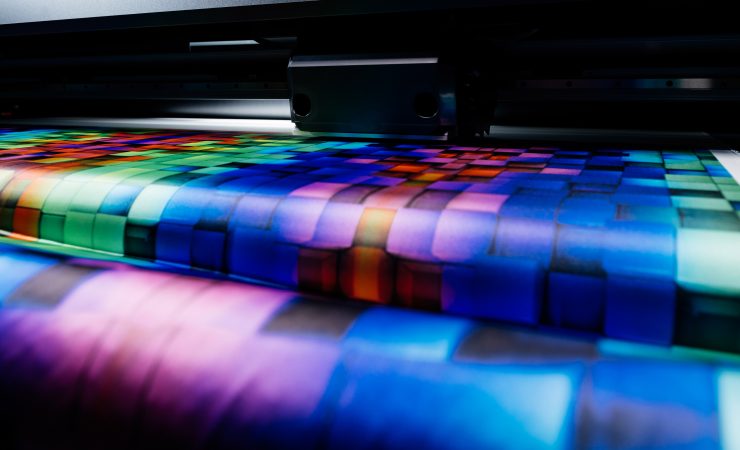When it came to forecasting the events of 2020, no-one on the planet had 2020 vision. But 2021 can’t possibly be as turbulent as its predecessor so perhaps some predictions are in order. Charlie Kortens asked some of print’s leading companies what the next 12 months have in store for digitally printed textiles
Commercial print has had a difficult year, but that doesn’t mean it has been devoid of all hope. Textile printing has proven that it can remain buoyant amidst a sea of troubles and there is plenty of expectation that the market will keep growing across 2021.
One company which has a ‘very promising pipeline,’ in place for next year is EFI and its Reggiani operation, based in Northern Italy. Due to its location the company was among the very first outside of China to feel the effects of Covid-19. Still, as Adele Genoni, senior vice president and general manager at EFI Reggiani, explains, this wasn’t necessarily a disadvantage. ‘We had to weather that storm straightaway,’ Ms Genoni says. ‘As early as March we were looking at a ‘new normal’ and preparing to find opportunities in the crisis. Throughout the pandemic we haven’t stopped innovating, and we’ve put new processes in place to keep delivering our solutions to our customers.’
Ms Genoni says that it should be an exciting year for digital textile printers as, ‘Supply chains are getting shorter, with products being produced nearer to the consumer. When you consider digital’s environmental advantages, short run capabilities, efficiency, compatibility with online retail and ability to personalise and customise, it is the perfect fit.’
These themes, reshoring, personalisation, sustainability and increased online activity are ones that are clearly at the forefront of many people’s minds, but the growth of decor products has also caught the eye. Brett Newman, managing director at Hybrid Services, Mimaki’s exclusive distributor for the UK and Ireland, says, ‘2020 has undoubtedly been very challenging for everyone but we’ve seen growth in décor and personalisation, with more people engaging in DIY and home improvements throughout Lockdown.
‘We’ve also seen an increase in crafting and furnishings, with people taking time to make their houses into a homes. This growth in consumer demand has set a trend that we fully anticipate to carry on into 2021. People’s buying habits have been forced to change through not visiting bricks and mortar retail, they’ve discovered more creative products online, and that in turn has driven demand for personalised and bespoke products.’

Trapped inside during Lockdown, people have been turning their houses into homes
This trend of applications growing in popularity in 2020, then maintaining that new status in 2021, is one that has also been recognised by Phil McMullin, sales manager, ProGraphics at Epson. ‘The increase in personalisation and web ordering that we saw over the course of Lockdown looks like it will only continue to develop further as we move into next year,’ he explains. ‘The myriad of businesses now offering personalised T-shirts, mugs, photos, keyrings and more has reinforced the importance of reliable, on-demand digital printing.’
Clearly interior décor and personalisation have really come of age over the course of the crisis, they are highlighted again by HP’s Johan Spies, WW & EMEA low volume product manager, textiles. ‘This year most of us have experienced how our home became a place to work, educate our children, exercise, and relax, and as such we have seen the interior decoration market grow accordingly,’ Mr Spiers says. ‘We’ve also found that this year an increasing number of customers want their print jobs to be personalised.
‘Demand for digital and personalised printing is growing at a rate of 7.2% every year as consumers and businesses tailor their print jobs to their needs. In response to this trend, print service providers who can meet this demand will win the marketplace.’
For his part George Benglopoulos, CEO at Polyprint emphasizes how demand for DtG products has remained strong despite the pandemic. He says that due to this, and a surge in one off and online orders, companies have been forced to operate on-demand, without stock. ‘Flexibility is the key here’ Mr Benglopoulos explains. ‘The DtG print-on-demand business model is ideal for web driven operations. Covid-19 has altered the market, accelerating the shift to e-commerce, challenging traditional business methods and creating an evolution in the textile industry. It really comes down to cost per print, uptime on your printer and quick ROI with minimal investment costs. Demand is off the charts, but supply is the tricky part, as global shipments have been reduced.’
Rob Goleniowski, head of sales at Roland DG, UK and Ireland, is also watching this shift towards e-commerce. He says, ‘Covid-19 restrictions caused consumers to flock online to make purchases and for interactions, and this trend is only set to continue. As a result, it has become vital for print businesses to strengthen their online presence to capture the increasing online market and to tap into the growing personalisation market which is set to reach £1 billion over the next 12 months.’
New customers, new applications
Textiles was obviously better placed to endure the pandemic than many other parts of the digital print market. There was nothing those dependent on hospitality, exhibitions or tourism could do when those sectors were closed down, but, as we have seen, demand stayed strong for décor, clothing and related items. We’ve touched on aspects of this already, but what applications will continue to drive the growth in the sector, and what customers will they be marketed at?
One obvious area, highlighted by Polyprint’s sales and support supervisor Kostis Gounaris, is products inspired by Covid-19. ‘People’s need to stay safe and protected during the pandemic has compelled the mass production of face masks,’ he says. ‘Masks infused with virus inactivation technology are widely researched around the world. Our need to express ourselves through these difficult times, has created a mask personalisation trend, where they are printed with amazing designs. These customisation trends will move beyond traditional garments in the near future to accessories like socks, belts, ties, bags and purses.’

PersBiz, Roland DG’s digital online store, enables print providers to start selling online and provide personalisation options to consumers
Hybrid’s Mr Newman highlights products that have been given a boost by lockdowns. ‘Home décor, personalised garments and customised soft furnishings have seen growth already and that trend will continue,’ he says. ‘Items used around the home that are customised to the buyer’s requirements will also continue to grow in popularity. Customised options and the ability to create unique colourways of existing designs that are then digitally printed and ordered in short runs engage the buyer in the creative process, for which a premium can be charged, just as you may pay more for a made-to-measure suit from Saville Row than one bought ‘off the peg’.’
It seems these markets are the ones everyone is keeping an eye on. Ms Genoni also points out the growth in home décor and sportswear, which she says was previously driven by a global rise of a middle class and athleisure lifestyles, and has been accelerated by Covid and consciousness on health and wellbeing. She adds that, ‘When this is combined with the desire for personalised products, digital is the answer. Other trends we are keeping an eye on for similar reasons include the technical textiles sector and sportswear, this is where we are promoting our sustainable processes range like direct sublimation as it makes very good sense to combine sports, and therefore physical health, with sustainability.’
HP’s Mr Spies says that, ‘Personalised textiles in all segments are growing in popularity, particularly those sold via online stores. Our network of PSPs report that short runs, customisability and fast delivery are the most important factors to their customers, and this consumer behaviour will continue to drive growth in the sector. Personalised sports textiles and custom collections will continue to grow and being able to deliver this on a semi-industrial scale will be crucial to success.’
Mr Goleniowski adds that Roland’s ‘target market has not changed over the past year, but we have adapted to expand our focus and develop more solutions for not just dye-sub, but DtG and other interior decor applications. Interior decor has shown promising resilience in these difficult times, relative to other printing categories, and the market is in double digit growth and forecast to reach $7.8bn by 2023. We can expect to see an ever-expanding range of digitally printed household items in 2021, from curtains to tablecloths to cushions.’
Mr McMullin says that Epson’s priority is taking advantage of the ongoing reshoring of textile production. He expects to see continued growth in local production across the UK, particularly across fast fashion, as manufacturers look to gain greater control over their supply chains.
‘We’re targeting local producers in the UK,’ Mr McMullin explains. ‘Where previously they were printing textiles abroad and finishing locally, we’re shifting their businesses away from this and towards local manufacturing to give them better control of their production in terms of time, quality, cost and waste. The restraints Covid has had on supply chains across different sectors has forced a lot of companies to consider how reshoring can change their business for the better.

Epson says its commitment to textiles is reflected by the opening of a new factory in Japan, manufacturing the Monna Lisa range.
‘If you’re in the textiles business, you might order 3000 of the same garment from China to get the right price. But the market doesn’t want 3000 of the same garment but rather wants one personalised item per customer, therefore companies need to plan how they can keep up with this trend in 2021.’
Cornerstone
The textile market is consistently predicted to be one of digital printing’s leading growth areas, driven by its sustainable credentials, demand for personalised products and its relatively simple path to entry. But with so many other parts of print being better established, how important is textiles to print’s leading companies? The answer is an emphatic and resounding, ‘very.’
‘Textiles were always central for us,’ Ms Genoni says of EFI Reggiani. ‘We have always been aware of the strategic opportunity and the potential of digital transformation. As such we’ve renewed all of our digital printers in recent years, single pass having changed the rules. Our commitment has been proven recently by our winning an InterTech Award, the first ever handed out for a textile solution, and by the growing popularity of our BOLT in markets like Italy and Pakistan, where a fourth EFI textile printer was recently installed.’
Mimaki can boast similar longstanding credentials. ‘Textile solutions have been part of our business strategy since the 1990s,’ said Mr Newman. ‘Mimaki was instrumental in the enablement of digital textile printing and this sector continues to be an important focus for the company, with new products added in recent months including the hybrid Tx300P-1800MkII dye-sub/direct-to-textile printer.’
For Mr Goleniowski Roland demonstrated its commitment ‘through our investment to bring to market the ZT-1900, EJ-DECO, XT-S and further back the RT-640M. All these products offer choice and flexibility to the textile producers across a wide range of applications. These customers in many cases also sell other products that can be produced on other Roland DG machines, so our investment is about allowing our customers to use more of our machines across more aspects of their business. It’s win win!’
Mr McMullin points out that, ‘Approximately 5% of the world’s textiles are digitally printed and Epson sees a great growth opportunity in shifting the market further, which is reflected by the opening of our new factory in Japan, manufacturing the Monna Lisa range. We’ve had some bigger pieces of kit for some time now and with the launch of the new Monna Lisa ML-8000 we have an entry level industrial production device that we believe will appeal much more to the smaller companies that are producing textiles more locally.’

Adele Genoni with EFI’s InterTech Award, the first awarded for textile printing
It is DtG specialist Polyprint that can boast the most timely confirmation of textile’s growth, announcing the creation of its subsidiary Polyprint USA, based in North Carolina, only this month (December 2020). ‘This new entity will be operating fully staffed and stocked to better serve Polyprint’s current and future equipment users, generating a closer bond with its US customer base,’ finishes Mr Benglopoulos. ‘Polyprint’s strategic growth throughout the USA with carefully selected dealers will contribute to streamlining its efficiency by delivering leading local customer support and producing business opportunities for all parties included.’
Exciting times indeed.





